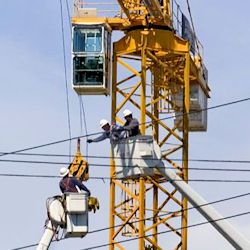Cranes and Power Lines
One way to determine the line's voltage is to ask the line's owner or operator.
The utility must respond to such a voltage inquiry within two working days.
If you use Table A in the previous section to determine the minimum clearance distance, you must determine whether any part of the crane, load or load line could get closer than the Table A distance to a power line if the equipment is operated up to its maximum working radius in the work zone.
If you determine that part of the crane, load, or load line could come closer to the power line than the required minimum clearance distance (either 20 feet or the Table A clearance), you must either de-energize and ground the line or take specified steps to maintain the required minimum clearance distance. These options will now be discussed.
De-Energize and Grounding
De-energizing and visibly grounding the line will protect against electrocution and avoid the need for additional precautions. However, the employer must rely on the owner or operator of the power line's to take these steps. Utilities are generally unwilling to de-energize their lines because doing so will cut off service to their customers. As a result, this precaution will usually not be available. You must assume all power lines are energized unless the utility owner/operator confirms the power line has been, and continues to be, de-energized, and the line is visibly grounded at the worksite.
Maintaining Required Minimum Clearance Distance
You must take all of the following steps:
- Conduct a planning meeting with the crane operator and the other workers who will be in the area of the equipment or load to review the location of the power line(s), and the steps that will be implemented to prevent encroachment/electrocution.
- If tag lines are used, they must be non-conductive.
- Erect and maintain an elevated warning line, barricade, or line of signs equipped with flags or similar high-visibility markings at the minimum clearance distance.
- If the operator cannot see the elevated warning line, use a dedicated spotter to signal the operator that the crane is passing the marked line.
In addition, you must use at least one of the following precautions:
- a dedicated spotter in continuous contact with the operator;
- a proximity alarm set to give the operator sufficient warning to prevent encroachment;
- a device such as a range control warning device set to automatically give the operator sufficient warning to prevent encroachment;
- a device that automatically limits the crane's range of movement, set to prevent encroachment; and
- an insulating link/device installed between the end of the load line and the load.
Knowledge Check Choose the best answer for the question.
4-3. To maintain the required minimum clearance distance from power lines while operating a crane, which procedure must you follow?
You forgot to answer the question!

